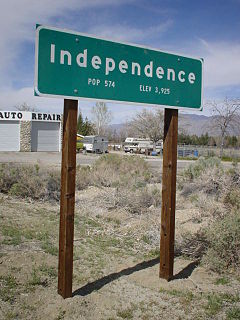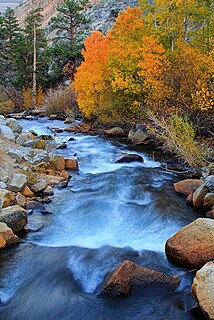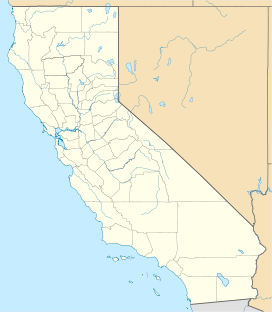
Bishop is a city in California, United States. It is the largest populated place and only incorporated city in Inyo County. Bishop is located near the northern end of the Owens Valley, at an elevation of 4,150 feet (1,260 m). The city was named after Bishop Creek, flowing out of the Sierra Nevada; the creek was named after Samuel Addison Bishop, a settler in the Owens Valley. Bishop is a commercial and residential center, while many vacation destinations and tourist attractions in the Sierra Nevada are located nearby.

Independence is a census-designated place in Inyo County, California. Independence is located 41 miles (66 km) south-southeast of Bishop, at an elevation of 3930 feet. It is the county seat of Inyo County, California. The population of this census-designated place was 669 at the 2010 census, up from 574 at the 2000 census.

Owens Valley is an arid valley of the Owens River in eastern California in the United States. It is located to the east of the Sierra Nevada, west of the White Mountains and Inyo Mountains, and north of the Mojave Desert. It sits on the west edge of the Great Basin. The mountain peaks on the West side reach above 14,000 feet (4,300 m) in elevation, while the floor of the Owens Valley is about 4,000 feet (1,200 m), making the valley the deepest in the United States. The Sierra Nevada casts the valley in a rain shadow, which makes Owens Valley "the Land of Little Rain." The bed of Owens Lake, now a predominantly dry endorheic alkali flat, sits on the southern end of the valley.

The 1872 Owens Valley earthquake – also known as the Lone Pine earthquake – struck on March 26 at in the Owens Valley, with the epicenter near the town of Lone Pine. Its magnitude has been estimated at 7.4 to 7.9, with a maximum Mercalli Intensity of X (Extreme). It was one of the largest earthquakes to hit California in recorded history and was similar in size to the 1906 San Francisco earthquake. Twenty-seven people were killed and fifty-six were injured.

Owens Lake is a mostly dry lake in the Owens Valley on the eastern side of the Sierra Nevada in Inyo County, California. It is about 5 miles (8.0 km) south of Lone Pine, California. Unlike most dry lakes in the Basin and Range Province that have been dry for thousands of years, Owens held significant water until 1913, when much of the Owens River was diverted into the Los Angeles Aqueduct, causing Owens Lake to desiccate by 1926. Today, some of the flow of the river has been restored, and the lake now contains some water. Nevertheless, as of 2013, it is the largest single source of dust pollution in the United States. The lake was the epicenter of a magnitude 5.8 earthquake that occurred on June 24, 2020.

Stovepipe Wells is a way-station in the northern part of Death Valley, in unincorporated Inyo County, California.
The Shoshone or Shoshoni are a Native American tribe with four large cultural/linguistic divisions:

Fort Tejon in California is a former United States Army outpost which was intermittently active from June 24, 1854, until September 11, 1864. It is located in the Grapevine Canyon between the San Emigdio Mountains and Tehachapi Mountains. It is in the area of Tejon Pass along Interstate 5 in Kern County, California, the main route through the mountain ranges separating the Central Valley from the Los Angeles Basin and Southern California. The fort's location protected the San Joaquin Valley from the south and west.

Manzanar was a town in Inyo County, California, founded by water engineer and land developer George Chaffey.

Laws is an unincorporated community in Inyo County, California. Laws is located 4 miles (6.4 km) northeast of Bishop on U.S. Route 6, towards the Nevada state line.

Haiwee is an unincorporated community in Inyo County, California. It is located on the Southern Pacific Railroad 24 miles (39 km) south-southwest of Keeler, at an elevation of 4075 feet.

Bend City is a former settlement in Inyo County, California. It was located on the Owens River near the modern-day town of Kearsarge. Founded in the 1863, Bend City was originally a mining camp. Bend City was the site of the first county bridge spanning the Owens River. The 1872 Lone Pine earthquake changed the course of the river away from the townsite, which had already declined. The site is now registered as California Historical Landmark #209.

Owensville is a former settlement in Inyo County, California. It was located west of the future site of the modern-day town of Laws. Owensville was started as a mining camp in 1863. By 1871 it had been abandoned. The former settlement site is on U.S. Route 6 north of Bishop, California.

Fort Independence, originally named Camp Independence, was a fort located in the Owens Valley, 3 miles (4.8 km) north of present-day Independence, Inyo County, eastern California. The U.S. Army post was active from 1862 to 1877.

The Sebastian Indian Reservation (1853-1864), more commonly known as the Tejon Indian Reservation, was formerly at the southwestern corner of the San Joaquin Valley in the Tehachapi Mountains, in southern central California.
The Owens Valley War was fought between 1862 and 1863, by California Volunteers and local settlers against the Owens Valley Paiutes, and their Shoshone and Kawaiisu allies, in the Owens Valley of California and the southwestern Nevada border region. The removal of a large number of the Owens River Native Californians to Fort Tejon in 1863, was considered the end of the war. Minor hostilities continued occasionally until 1867.

San Francis Ranch was the ranch of Owens Valley pioneer Samuel A. Bishop and his wife, located on a creek later named for him southwest of modern Bishop, California also named after him. Bishop founded the ranch here in August 1861, after he and his wife drove 500 cattle and 50 horses from Fort Tejon to this spot in the Owens Valley, intending to sell cattle to the miners in the boomtown of Aurora and other mining camps in the area.
William Mayfield (1810–1862) was an American pioneer in Illinois, Texas, and California; a soldier, farmer, miner, and a cattleman. He led Tulare County militia to aid settlers in the early part of the Owens Valley Indian War and was killed in the Battle of Mayfield Canyon.
Joaquin Jim was a Western Mono, war leader of the Owens Valley Indian War. Joaquin Jim, implacable war leader of the Mono allies of the Owens Valley Paiute, never surrendered to American forces or made peace with them, but reported to have ceased warfare against them in 1864.

Battle of Bishop Creek was one of the early engagements of the Owens Valley Indian War fought on April 6, 1862 along Bishop Creek, in what is now Inyo County, California.














